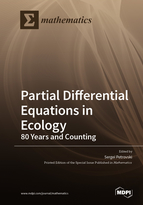Partial Differential Equations in Ecology: 80 Years and Counting
A special issue of Mathematics (ISSN 2227-7390). This special issue belongs to the section "Mathematical Biology".
Deadline for manuscript submissions: closed (31 January 2020) | Viewed by 42341
Special Issue Editor
Interests: mathematical ecology; climate change; mass extinctions; nonlinear dynamics
Special Issues, Collections and Topics in MDPI journals
Special Issue Information
Dear Colleagues,
The application of partial differential equations (PDEs) in ecology has a long history dating back to seminal works by Fisher (1937) and Kolmogorov et al. (1937), in which the travelling wave solutions of a scalar diffusion-reaction equation were discovered and studied. These papers laid the foundation of the mathematical theory of population travelling waves that was later applied, with great success, to biological invasions and other phenomena involving population spreading. Fifteen years later, Alan Turing’s work on chemical morphogenesis (1953) appeared to demonstrate that a system of two coupler PDEs gives rise to pattern formation due to diffusive instability. This discovery, especially after Segel & Jackson (1972) revealed its ecological context, led to an outbreak of research on all aspects of the population dynamics in space and time using PDEs of the diffusion-reaction type. The ecological significance of this was eventually examined and justified in an influential review by Holmes et al. (1994).
New times brought new challenges and new ideas. Over the last 25 years, certain limitations of the PDE-based framework were revealed and understood, and a number of alternative mathematical techniques were developed for ecological applications. However, on appropriate spatial and temporal scales, PDEs remain as fully relevant and powerful modelling tools, which are nowadays widely used both to bring new light to some old problems and to gain insight into new ones. This Special Issue aims to summarize and highlight the current role of PDE-based models in ecology and population dynamics. We welcome papers in which the traditional diffusion-reaction models are applied to clearly defined problems of ecological significance. We especially welcome papers in which the PDE framework is extended beyond the diffusion-reaction paradigm (e.g., the reaction–telegraph equation or Cahn–Hilliard equation). Of particular interest are papers in which emerging ecological problems and trends are addressed, such as the effect of the climate change. Both analytical studies and simulation-based studies will be considered.
Prof. Dr. Sergei Petrovskii
Guest Editor
Manuscript Submission Information
Manuscripts should be submitted online at www.mdpi.com by registering and logging in to this website. Once you are registered, click here to go to the submission form. Manuscripts can be submitted until the deadline. All submissions that pass pre-check are peer-reviewed. Accepted papers will be published continuously in the journal (as soon as accepted) and will be listed together on the special issue website. Research articles, review articles as well as short communications are invited. For planned papers, a title and short abstract (about 100 words) can be sent to the Editorial Office for announcement on this website.
Submitted manuscripts should not have been published previously, nor be under consideration for publication elsewhere (except conference proceedings papers). All manuscripts are thoroughly refereed through a single-blind peer-review process. A guide for authors and other relevant information for submission of manuscripts is available on the Instructions for Authors page. Mathematics is an international peer-reviewed open access semimonthly journal published by MDPI.
Please visit the Instructions for Authors page before submitting a manuscript. The Article Processing Charge (APC) for publication in this open access journal is 2600 CHF (Swiss Francs). Submitted papers should be well formatted and use good English. Authors may use MDPI's English editing service prior to publication or during author revisions.
Keywords
- Pattern formation
- Spatiotemporal complexity and chaos
- Population waves
- Biological invasion
- Biological control
- Competition
- Prey–predator interaction
- Host–parasite interaction
- Climate change
- Landscape geometry
- Habitat fragmentation
- Agroecology






